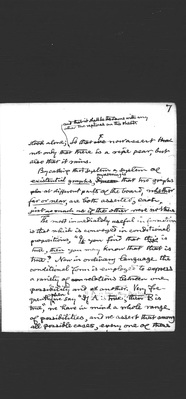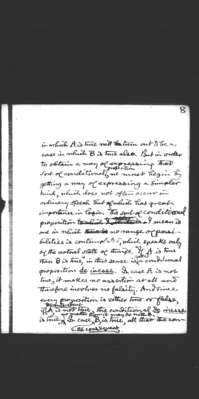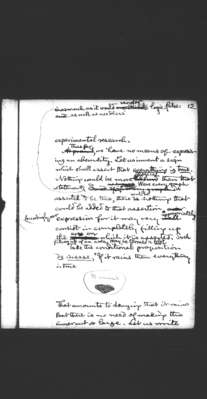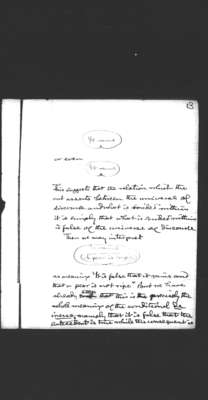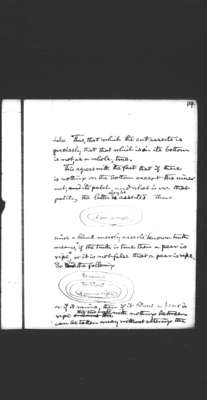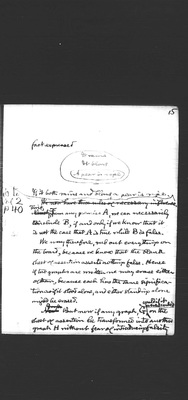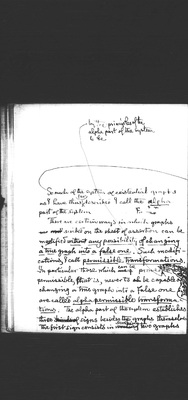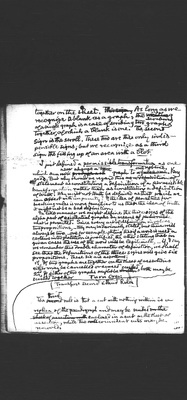Pages That Need Review
MS 455-456 (1903) - Lowell Lecture II
9
7
stood alone; and that it shall be the same with any other two replicas on the sheet, so that I now assert not only that there is a ripe pear, but also that it rains.
By calling this system a system of existential graphs, I mean my meaning is that two graphs at different points of the board, whether far or near, are both asserted, each just as much as if the other were not there.
The most immediately useful information is that which is conveyed in conditional propositions, “If you find that this is true, then you may know that that is true.” Now in ordinary language the conditional form is employed to express a variety of relations between one possibility and another. Very frequently when we say “If A is true, then B is true,” we have in mind a whole range of possibilities, and we assert that among all possible cases,every one of those
10
8
in which A is true will be turn out to be a case in which B is true also. But in order to obtain a way of expressing that sort of conditional proposition, we must begin by getting a way of expressing a simpler kind, which does not often occur in ordinary speech but which has great importance in logic. The sort of conditional proposition I mean is one in which no range of possibilities is contemplated, which speaks only of the actual state of things. “If A is true then B is true,” in this sense is called a conditional proposition de inesse. In case A is not true, it makes no assertion at all and therefore involves no falsity. And since every proposition is either true or false, if the antecedent, A, is not true, the conditional de inesse is true, no matter how it may be with B. In case the consequent, B, is true, all that the conditional
11
9
de inesse asserts is true, and therefore it is true, no matter how it may be with A. If however the antecedent, A, is true, while the consequent, B, is false, then, and then only is the conditional proposition de inesse false. This sort of conditional says nothing at all about any real connection between antecedent and consequent; but limits itself to saying “If you should find that A is true, then you may know that B is true,” never mind the why or wherefore.
The question of the proper way of expressing a conditional proposition de inesse in a system of existential graphs has formed the subject of an elaborate investigation with the reasoning of which I will not trouble you. Suffice it to say that it is found that there is essentially but one proper mode of representing it. Namely, in order to assert of the universe of discourse that if it
13
11
of discourse; while the statement “It rains” is a mere supposition. Let us say that that bottom inside the outer cut represents another universe, a universe of supposition, and that it is only in that universe that it is said to rain. Besides this graph, “It rains” the bottom of the outer cut contains the inner cut which interrupts its surface; and inside the inner we will make believe that a patch is put on with a surface like that of the blackboard, although cut off from it. I use the word area for any part of the surface [unbounded?] or bounded by cuts, never extending [through??] a cut.
The outer cut is itself on the sheet the sheet of assertion although the whole of its interior is severed from that sheet. Now this outer cut by being on the sheet of assertion, represents the conditional proposition de inesse to be true of the universe of discourse.
[insert next (unnumbered) page here??]
In order to get an insight into how the scroll represents the conditional proposition de inesse, we must make a little
15
12
experimental research.
At present Thus far, we have no means of expressing an absurdity. Let us invent a sign which shall assert that everything is true. Nothing could be more absurd illogical than that statement, inasmuch as it would annihilate render logic false as well as needless. Were every graph asserted to be true, there would be nothing that could be added to that assertion. Accordingly, our expression for it may very appropriately consist in completely filling up the area on which it is asserted. Such filling up of an area, may be termed a blot.
Take the conditional proposition de inesse, “If it rains then everything is true
That amounts to denying that it rains. But there is no need of making the inner cut so large. Let us write
16
13
[scroll with small blot ??]
or even
[scroll with infinitesimal blot ??] This suggests that the relation which the cut asserts between the universe of discourse and what is scribed within it is simply that what is scribed within is false of the universe of discourse.
Then we may interpret
as meaning “It is false that it rains and that a pear is not ripe.” But we have already seen that this is precisely the whole meaning of the conditional de inesse; namely that it is false that the antecedent is true while the consequent is
17
14
false. Thus, that which the cut asserts is precisely that that which is on its bottom is not, as a whole, true.
This agrees with the fact that if there is nothing on the bottom except the inner cut, its patch may be asserted. Thus
since a blank merely asserts known truth means, "if the truth is true then a pear is ripe," or it is not false that a pear is ripe. So in the following
or if it rains, then if it blows, a pear is ripe. The two cuts with nothing between can be taken away without altering the
18
15
fact expressed If it both rains and blows a pear is ripe.
[Go to Vol 2 p 40 (MS 456)]
We now have three tules of necessary inference. First, from any premiss A, we can necessarily conclude B, if and only if we know that it is not the case that A is true while B is false.
We may, therefore, rub out everything on the board, because we know that the blank sheet of assertion asserts nothing false. Hence if two graphs are written one may erase either of them, because each has the same signification as if it stood alone, and either standing alone might be erased.
But now if any graph, G, could if it were scribed on the sheet of assertion be transformed into another graph H without fear of introducing falsity
19
So much of the system of existential graphs as I have thus far described I call the alpha part of the system.
There are certain ways in which graphs scribed on the sheet of assertion can be modified without any possibility of changing a true graph into a false one. Such modifications, I call permissible transformations. In particular those which can be proved by the principles of the alpha part of the system to be permissible, that is, never to be capable of changing a true graph into a false one are called alpha permissible transformations. The alpha part of the system establishes three kinds of signs besides the graphs themselves. The first sign consists in writing scribing two graphs
20
together on the sheet. As long as we recognize a blank as a graph, the writing scribing of a single graph is a case of scribing two graphs together, of which a blank is one. The second sign is the scroll. These two are the only indispensible signs; but we recognize as a third sign the filling up of an area with a blot.
I just defined a permissible transformation as one which can not produce a ?? never change a true graph to a false one one not true. Very good. But why should we regard this statement as constituting a definition of a permissible transformation rather than as constituting a definition of truth? Why might not truth be defined as that which we can assert with impunity? If the idea of penalties for breaking rules is more familiar to us than the idea of truth it might not be a bad definition.
In like manner we might define the three signs of the alpha part of existential graphs by means of permissible what is permitted. Since every act of definition involves two propositions,— they may be variously stated, but there will always be two,— one for example stating that if a word is used a certain interpretation is justified, the other stating that in given cases the use of the word will be legitimate,— if, I say we remember this double character of definition, we shall see that the definitions of the three signs will give six propositions. These six are as follows: 1st, If two graphs are together on the sheet of assertion, either may be cancelled or erased. 2nd, If either of two graphs might be written scribed, both may be scribed together. [written here by Peirce: "Turn over." and under that: "Transpose second & third Rules"]
The second third rule is that a cut with nothing within is a replica of the pseudograph and may be scribed on the sheet of assertion with enclosed in a cut on the sheet of assertion, while two coincident cuts may be removed.
